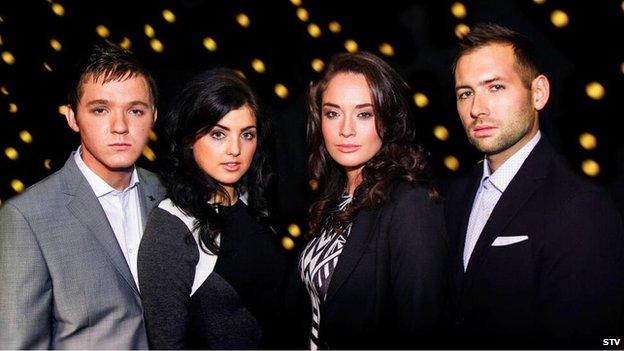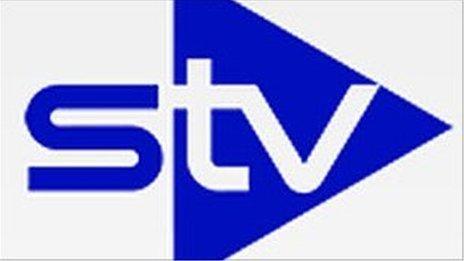STV Glasgow TV station goes on air
- Published

Colin Stone, Storm Huntley, Jennifer Reoch and David Farrel are the presenting team for the new Riverside Show on STV Glasgow
The first of a proposed chain of local TV stations across Scotland has gone on air.
STV won the licence for a station focussed on the Glasgow area in January 2013.
The new station is being broadcast across Freeview, Sky and cable.
The company has also won a licence covering Edinburgh and more licences for other parts of Scotland are expected to be advertised by the regulator Ofcom.
STV director of broadcasting Bobby Hain told BBC Radio Scotland's Good Morning Scotland programme: "Like any new business there's a degree of risk and nothing is a sure-fire bet.
"But we have 50 years of television experience and we're bringing all of that to this new model of television, we know the area well and we think we know the audience well."
The market for local TV is so far unproven and many in the traditional broadcasting industry are highly sceptical about whether local TV stations can prove both commercially viable and provide a useful public service.
Several previous attempts at local TV - Channel M in Manchester and Lanarkshire TV in Scotland - failed.
STV says local TV represents a £1 million investment for the company and expects the stations to be breaking even within a year.
The current scheme to set up a local TV system was the brainchild of the former UK culture secretary Jeremy Hunt. It was partly designed amid concerns, which have now been allayed, that ITV in England might abandon its traditional regional news service.
Since the current round of local TV licensing began, a few stations have taken to the air in England. Viewing figures are only available for one - London Live.
Despite having the biggest potential market of any local TV station in the UK - and even claims by some in the London media that it was the most significant development in British TV since the start of Channel 5 - some programmes have attracted only hundreds of viewers,
Pros and cons
STV's Glasgow and Edinburgh stations have one crucial advantage over the others set up so far - and one serious disadvantage.
The advantage is that they are owned by STV. As well as expertise, there will be opportunities for tie-ups and promotions between the local stations and STV's main channel. This could help attract viewers and advertisers, adding to the chance of the local stations becoming viable.
Even the trails for STV Glasgow being shown on the main STV service give the new channel a visibility other local TV operators may envy.
The disadvantage is that the stations will broadcast on Channel 23 on Freeview. Local TV in England is on the far more visible Channel 8 which is used in Scotland for the Gaelic channel BBC Alba.

The channel will be available to two million digital viewers in the west of Scotland on Freeview channel 23
This means there is less chance of casual viewers simply landing on the channel. STV Glasgow will have to work harder to make an impact.
Some supporters of the concept of local TV were both surprised and disappointed the Glasgow and Edinburgh licences were awarded to an established broadcaster despite rival bids.
STV argues the new channels will not be "STV2" and stresses the opportunity they will provide to media students at Glasgow Caledonian and Napier universities.
The channel is also available to viewers across the west of Scotland on Sky and Virgin while on Freeview many well beyond Glasgow may still manage to tune in - again a visibility some other local services lack.
Relaxed regulations
The company has declined the offer of some TV licence cash to help get the stations going but is confident they will be breaking even after a year. Basically they will need to attract enough advertising and sponsorship to cover costs.
The main local programme on the Glasgow station will be a two hour magazine show in the early evening. There will be some other original programmes while other programmes will be bought in or come from STV's archives.
Repeats of Take The High Road and Taggart may win some viewers while STV will be hoping a subtitled Polish drama finds a niche.
However the statutory obligations surrounding local TV - such as the number of hours of local programmes and how they are resourced - are deliberately relaxed to help give them the best possible chance of success, unburdened by costly regulations.
On the other hand, there is an acceptance, acknowledged by former culture secretary Jeremy Hunt, that some of the local TV stations elsewhere could fail and simply go off the air - something which seems highly unlikely with STV's involvement.
A total of 25 licences have been awarded but most are not on the air yet. Rumours circulate that some may never see the light of day.
More local TV licences in Scotland are expected to be advertised soon - potentially covering Dundee, Falkirk, Aberdeen, Inverness and Ayrshire.
Nobody has publicly confirmed an intention to bid for them so far.
- Published31 March 2014

- Published6 March 2014

- Published20 February 2013

- Published11 January 2013
